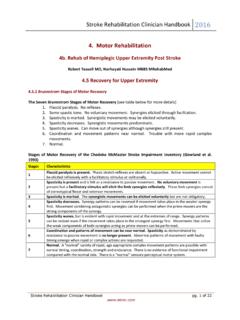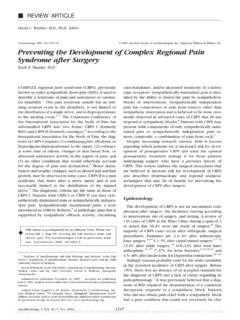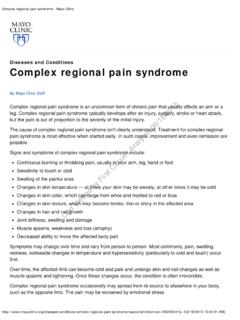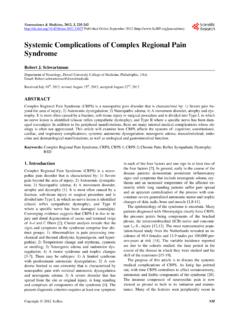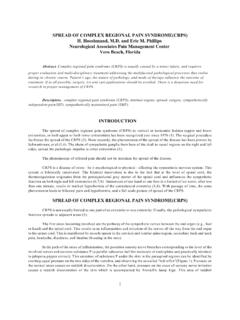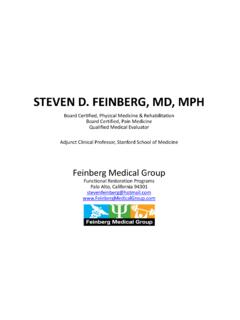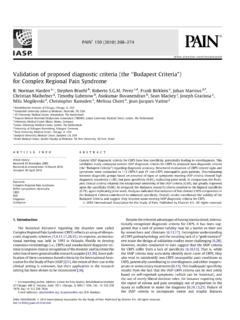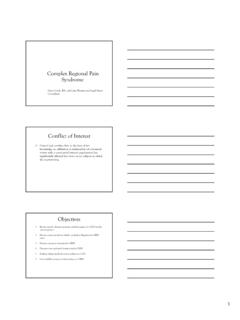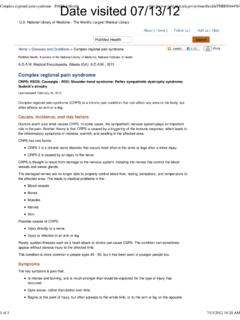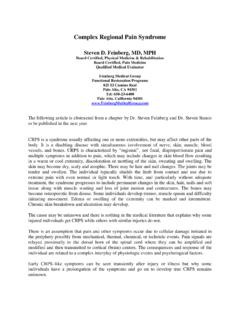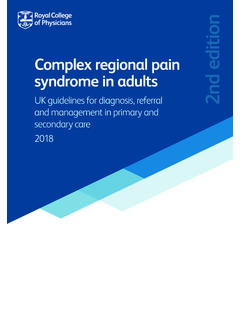Transcription of Hemiplegic Shoulder Pain & Complex Regional Pain Syndrome
1 11. Hemiplegic Shoulder pain & Complex Regional pain Syndrome pg. 1 of 51 EBRSR [Evidence-Based Review of Stroke Rehabilitation] 11 Hemiplegic Shoulder pain & Complex Regional pain Syndrome Joshua Wiener BHSc, Andreea Cotoi MSc, Ricardo Viana MD, John Chae MD, Richard Wilson MD, Tom Miller MD, Norine Foley MSc, Robert Teasell MD Last Updated: March 2018 Abstract Shoulder pain resulting from hemiplegia is a common clinical consequence of stroke. Hemiplegic Shoulder pain can occur as early as two weeks post-stroke but an onset of two to three months is more typical. Shoulder pain can negatively affect rehabilitation outcomes as good Shoulder function is a prerequisite for successful transfers, maintaining balance, effective hand function, and performing activities of daily living. Similarly, Complex Regional pain Syndrome is pervasive in Hemiplegic patients and can lead to significant medical complications.
2 This review summarizes the existing literature with regard to Hemiplegic Shoulder pain after stroke. Topics include prevalence, causes, impact, and management of Hemiplegic Shoulder pain with in-depth discussion of Shoulder subluxation, spasticity, contractures, and rotator cuff disorders. Management techniques including Shoulder positioning and related aids, intraarticular and intramuscular injections, electrical stimulation, active physical therapies, and other miscellaneous interventions are addressed. Finally, a discussion of the physiology, incidence, diagnosis, and treatment of Complex Regional pain Syndrome is included. 11. Hemiplegic Shoulder pain & Complex Regional pain Syndrome pg. 2 of 51 Key Points Hemiplegic Shoulder pain There is a wide variety of potential risk factors for Hemiplegic Shoulder pain . The association between Shoulder subluxation and Hemiplegic Shoulder pain is unclear. Hemiplegic Shoulder pain may be associated with spastic muscle imbalance and contracted Shoulder .
3 Hemiplegic Shoulder pain is not associated with rotator cuff disorders. There is high variability in the reported frequency of Hemiplegic Shoulder pain . Hemiplegic Shoulder pain may be associated with poorer upper limb abilities and lower quality of life. Sustained positioning and static stretching of the Hemiplegic Shoulder may not be effective in reducing pain or improving motor function. Slings may be effective in reducing subluxation and pain of the Hemiplegic Shoulder . While a wide variety of options are available, it is unclear which is the most effective. Strapping/taping may be effective in reducing Hemiplegic Shoulder pain . While a wide variety of options are available, it is unclear which is the most effective. Active therapies for the Hemiplegic Shoulder may be effective in reducing pain , increasing range of motion, and improving motor function. While a wide variety of options are available, it is unclear which is the most effective. Surface neuromuscular electrical stimulation may be effective in reducing subluxation and improving range of motion in the Hemiplegic Shoulder , although its effectiveness may be negatively correlated with stroke onset.
4 Intramuscular neuromuscular electrical stimulation may be effective in reducing Hemiplegic Shoulder pain , although its effectiveness may be negatively correlated with stroke onset. Transcutaneous electrical nerve stimulation may be effective in improving range of motion in the Hemiplegic Shoulder , although it may only be effective at higher intensity. Functional electrical stimulation may be effective in reducing subluxation and improving motor function in the Hemiplegic Shoulder . Peripheral nerve stimulation may be effective in reducing Hemiplegic Shoulder pain ; however the evidence is limited. Interferential electrical stimulation may be effective in reducing Hemiplegic Shoulder pain ; however the evidence is limited. High-voltage pulsed galvanic stimulation may be effective in reducing subluxation and joint displacement in the Hemiplegic Shoulder ; however the evidence is limited. Extracorporeal shockwave therapy may be effective in reducing Hemiplegic Shoulder pain ; however the evidence is limited.
5 Botulinum toxin may be effective in reducing pain and improving range of motion in the Hemiplegic Shoulder , but only when delivered in higher doses. 11. Hemiplegic Shoulder pain & Complex Regional pain Syndrome pg. 3 of 51 Given conflicting findings, further research is required to determine the efficacy of triamcinolone acetonide injections in treating Hemiplegic Shoulder pain . Hyaluronic acid may be effective in treating Hemiplegic Shoulder pain , although further research is warranted. Suprascapular nerve blocks may be effective in treating Hemiplegic Shoulder pain , although further research is warranted. Segmental neuromyotherapy may be effective in improving Hemiplegic upper limb motor function; however the evidence is limited. Surgical interventions may be effective in reducing Hemiplegic Shoulder pain ; however the evidence is limited. Acupuncture may be effective in reducing pain , increasing range of motion, and improving motor function in the Hemiplegic Shoulder .
6 Massage therapy may reduce Hemiplegic Shoulder pain and promote physiological relaxation, although further research is warranted. Combined acupressure and aromatherapy may reduce Hemiplegic Shoulder pain ; however the evidence is limited. Complex Regional pain Syndrome Complex Regional pain Syndrome is characterized by numerous peripheral and central nervous system changes in the absence of obvious nerve injury. The pathophysiology of Complex Regional pain Syndrome is not fully understood. There is high variability in the reported frequency of Complex Regional pain Syndrome . There is no ideal diagnostic test for the identification of CRPS. Corticosteroids are an effective treatment for reducing the severity of Complex Regional pain Syndrome . Nerve blocks may be effective in managing the symptoms of Complex Regional pain Syndrome , although further research is required. Mirror imagery therapy is an effective treatment for reducing pain and improving motor function in Complex Regional pain Syndrome .
7 Combined physiotherapy and aerobic exercise may be effective in reducing pain and improving psychosocial outcomes in Complex Regional pain Syndrome . Passive range of motion exercises may prevent the development of Complex Regional pains Syndrome , although further research is required. Acute injections of calcitonin may prevent the development of Complex Regional pain Syndrome , although further research is required. Dr. Robert Teasell Parkwood Institute, 550 Wellington Road, London, Ontario, Canada, N6C 0A7 Phone: Web: Email: 11. Hemiplegic Shoulder pain & Complex Regional pain Syndrome pg. 4 of 51 Table of Contents Abstract ..1 Key Points ..2 Table of Contents ..4 Hemiplegic Shoulder pain ..5 Shoulder Subluxation and Hemiplegic Shoulder pain ..6 Pathophysiology .. 6 Scapular Rotation .. 7 pain in Shoulder Subluxation .. 7 Spasticity, Contractures, and Hemiplegic Shoulder pain ..8 Pathophysiology .. 8 Spastic Muscle Imbalance.
8 8 Contracted/Frozen Shoulder .. 11 Rotator Cuff Disorders and Hemiplegic Shoulder pain .. 11 Frequency of Hemiplegic Shoulder pain .. 11 Functional Impact of Hemiplegic Shoulder pain .. 12 Management of Hemiplegic Shoulder pain .. 13 Positioning of the Hemiplegic Shoulder .. 13 Slings for the Hemiplegic Shoulder .. 15 Strapping/Taping the Hemiplegic Shoulder .. 16 Active Therapies for the Hemiplegic Shoulder .. 17 Electrical Stimulation of the Hemiplegic Shoulder .. 19 Botulinum Toxin Injections for the Hemiplegic Shoulder .. 23 Steroid Injections for the Hemiplegic Shoulder .. 24 Hyaluronic Acid Injections for the Hemiplegic Shoulder .. 26 Suprascapular Nerve Block for the Hemiplegic Shoulder .. 26 Segmental Neuromyotherapy for the Hemiplegic Shoulder .. 27 Surgery of the Hemiplegic Shoulder .. 28 Complementary & Alternative Therapies for the Hemiplegic Shoulder .. 28 Complex Regional pain Syndrome (CRPS) .. 30 Stages and Symptoms of CRPS.
9 30 Pathophysiology of CRPS .. 31 Frequency of CRPS .. 31 Diagnosis of CRPS .. 32 Management of CRPS .. 33 Pharmacological Interventions for CRPS .. 33 Mirror Imagery Therapy for CRPS .. 34 Exercise for the Prevention and Treatment of CRPS .. 36 Calcitonin for the Prevention of CRPS .. 37 Summary .. 38 References .. 41 11. Hemiplegic Shoulder pain & Complex Regional pain Syndrome pg. 5 of 51 Hemiplegic Shoulder pain Shoulder pain resulting from hemiplegia is a common clinical consequence of stroke and can result in significant disability (Najenson et al., 1971; Poduri, 1993). The pathogenesis of Hemiplegic Shoulder pain (HSP) is multifactorial and includes neurologic and mechanical factors, often in combination, which vary among individuals post stroke (Table ). Factors most frequently associated with HSP are glenohumeral subluxation (Grossens-Sills & Schenkman, 1985; Moskowitz et al., 1969; Savage & Robertson, 1982; Shai et al.)
10 , 1984), adhesive capsulitis, (Bloch & Bayer, 1978; Braun et al., 1971; Fugl-Meyer et al., 1974; Grossens-Sills & Schenkman, 1985; Hakuno et al., 1984; Rizk et al., 1984) and spasticity, particularly of the subscapularis and pectoralis muscles (Caldwell et al., 1969; Moskowitz, 1969; Moskowitz et al., 1969). Suggested causes of HSP include Complex Regional pain Syndrome (CRPS) (Chu et al., 1981; Davis et al., 1977; Perrigot et al., 1975), or injury to the rotator cuff musculotendinous unit (Najenson et al., 1971; Nepomuceno & Miller, 1974). The role of central post-stroke pain in the etiology of Shoulder pain is unclear (Walsh, 2001). Based on clinical and arthrographic findings, Lo et al. (2003) catalogued the different types of Shoulder dysfunction in patients with HSP within a year of stroke: 50% had adhesive capsulitis, 16% had Complex Regional pain Syndrome , and 4% had rotator cuff tears.
